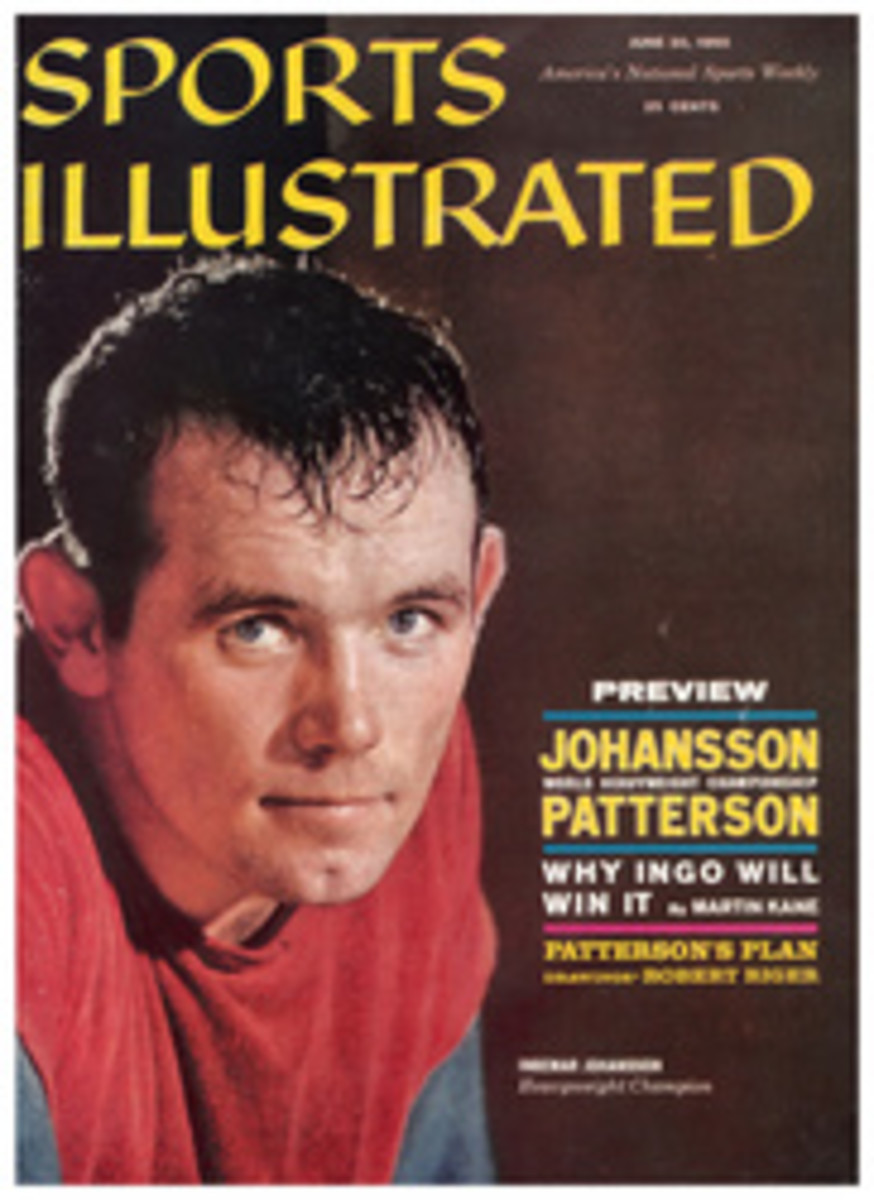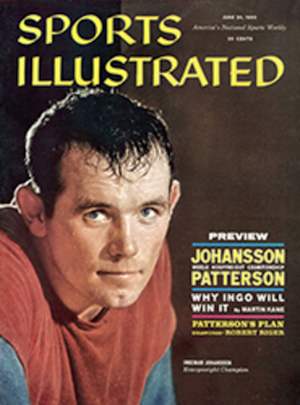
Eyes on 'Finisterre'
When the record entry of some 130 boats lines up off Newport, R.I. for the start of the Bermuda Race this week, virtually every sailor will have his eye on Carleton Mitchell's Finisterre. To an old rival like Colin Ratsey (shown at right aboard his yawl Golliwogg) the sight will be neither unfamiliar nor cheering. In 1956 Ratsey and the rest of the Bermuda skippers charged down to the island faster than any of them had ever before covered the 635-mile passage, only to discover that Mitchell had gone just a little faster.
In winning, the 38-foot 8-inch Finisterre became the smallest boat ever to win the Bermuda Trophy, a piece of silverware that ocean racers cherish above all others. She also earned some loud boos from rivals, who thought that her time allowance was too big.
"Some of these boats," grumped the owner of a long, tall sloop, "are beginning to win on mathematics."
Then it was 1958, and Finisterre, carrying a slightly increased rating, took the trophy again, the only boat to win two in a row in the 54-year history of the race. This time there were no boos. There was, however, a tendency to speculate on how Mitchell managed to do it. It was a point worth pondering.
The Bermuda Race—any deep-water race, for that matter—is so shot full of luck, confusion and false weather forecasts that there is no way of telling who is going to win. In 1948, for example, Henry Taylor's Baruna missed Bermuda altogether, then turned around and still managed to take first place.
In 1954 Dan Strohmeier on Malay went so far afield looking for wind that he arrived at the finish resigned to a position well back in the ruck. "Who won?" Strohmeier shouted to a committee boat, just after crossing the line.
"Malay," came back the answer.
While there may be no sure way to win a race, there are a number of ways to avoid losing. For even granted the element of luck, ocean racing is a game of mistakes, and the boat making the least mistakes is likely to win.
Mitchell, whom most of his rivals concede to be the best planner in racing today, is a man who remembers mistakes, particularly those he makes himself. He lost a transatlantic race in 1952 when he left his course to go wind hunting—and found instead a fiat calm. In 1957 he threw away the Annapolis race by tacking downwind in the hope of picking up more speed while his rivals slid steadily—and victoriously—down a straight course to the finish. After each of his losses, and after every one of his many victories as well, Mitchell jotted down his mistakes on scraps of paper. Then he entered his conclusions in a notebook entitled "Learned the Hard Way." This notebook is Mitchell's own abbreviated bible of ocean racing, a collection of purely personal reminders of the things that make a boat go in any ocean, in any weather. A selection of these notes is presented here. For ocean racers they may be a guide to future victories. For casual cruisers they contain valuable tips on preparing a boat for sea and for handling her when she is out on the water. And for landsmen, there is an indication of the effort, the persistence and the relentless attention to detail that have made Carleton Mitchell the winningest ocean racer of modern times.
MITCHELL'S MAXIMS
Here are the lessons learned in a lifetime of ocean racing by America's most successful deep-water sailor
•Most deep-water sailors believe that races are won on the long night watches. They aren't—just. They are won through preparation before the start, and they are won at the gun and over every foot of the course. Therefore, be completely ready, and once under way never let down.
•The two keys to ocean racing are crew and sails. In picking a crew, remember obligation to the boat must override all personal considerations except incompatibility.
•Try for one young eager beaver on each watch who will jump on minor errands, but balance him off with experienced men who are not slowed by age or temperament.
•In choosing sails, take as many as stowage permits. But don't go in for special-purpose sails like heavy-weather reachers or storm spinnakers until the bread-and-butter sails for normal conditions are perfect.
•Each sail should be assessed critically, preferably with the sailmaker aboard. Every effort should be made to achieve aerodynamic perfection in cut and trim. Sails also should be inspected for weaknesses. Check stitching along the seams, strength of cringles, condition of batten pockets. Hoist the sails against the sun and look for tiny tears or chafe marks, especially on spinnakers.
•Assemble all possible data on the course to be sailed. Study British Admiralty and U.S. Hydrographic Office publications—charts, sailing directions, weather maps, pilot charts. Read back through old issues of yachting magazines to see what has worked in the past. From bookstores specializing in out-of-print items, procure copies of Blunt, Findlay and other sailing directions of a century or more ago, when commerce depended on wind and current.
•Before leaving the dock, divide the boat into departments: engine, electrical, plumbing, galley, deck, rigging, sails. Decide which items are most likely to fail or be lost, and have spares, plus tools to cope.
•Make sure life rails will keep an unconscious man aboard with water sloshing deep in the scuppers.
•Make sure boat is floating on proper sailing lines. With everything aboard but crew, study trim. Boat must not be down by either end. Especially watch for squatting aft. Once under way, never forget, or let crew forget, that distribution of human weight will then govern trim, and that trim, in turn, affects speed.
•Helmsmanship is the most important single factor in ocean racing. Therefore, never let it be assumed steering is an automatic crew prerogative.
•No helmsman can do his best if he is distracted by other concerns. He should never try to direct operations on the foredeck, or watch competitors, or even call the trim of the sails. Before the start, an experienced crewman should be appointed to inform the man at the helm on courses and maneuvers of other boats, and possibly of right-of-way situations developing. Another crew member should be responsible for sails and trim.
•Although the ideal way to start is to hit the line with the gun, it is more important to have full way and clear wind. If a jam seems impending, stay away from favored end of line to avoid backwind and disturbed water. Try to be in a position to sail your own race as soon as possible.
•Don't make things neat until all sails are set and drawing—and especially never delay to coil a halyard before sheeting a sail. Get the boat going, then tidy up.
•After the start, concentrate on bringing the boat to her maximum speed, then settle down. Voices down, tails down. Under no circumstance except danger of collision should the man assigned to watching the trim of the jib be on the bow; then, and for the entire distance, headsails should be watched from a position near the mast.
•Commence watches as soon as possible. Don't let anyone burn out in the early stages. Send below those not needed; perhaps sleep will not be possible but lying down with eyes closed releases tension. Sleep shades and wax earplugs to cut out light and noise can be a great boon.
•Don't set rigid wheel tricks. Let the best men have the most time but never to the loss of sharpness. In heavy weather, limit helmsmen to 20 to 30 minutes; under pleasant conditions when the boat is in the groove, an hour is not too much.
•There should be no cockpit bull sessions. If the crew is stationed amidships—to windward in a breeze, to leeward in a drift—they are more aware of headsails and altered conditions which require action. The human ballast is where it belongs, and the helmsman is removed from temptation to chat.
•"Point" in a moderate breeze or sea. But when the wind is very light, or the weather so heavy that the boat is being stopped for lack of drive, fall off a little and concentrate on speed.
•In handicap racing, a boat should sail tactically against others her own size and class, hoping for the best in the over-all standings.
•Never let the crew get hungry—energy loss and irritability begins at once. If a midday start, pass soup and sandwiches on deck while sailing to the line, with more to follow when the initial excitement is over. For dinner the first night, ideal meal is beef stew made ashore and warmed below—the squeamish can sop at the gravy, the hungry can make a hearty meal.
•While still close to the coast, keep constant watch for new wind in light, variable conditions. Watch the direction taken by any rising smoke. Scan mouths of bays and rivers; frequently they act as wind funnels, and a tack toward them may pay. Also remember wind tends to draw on or off shore, sometimes providing a lift.
•In a moderate breeze, call the jib by watching when luff goes soft. In heavy winds, watch the sag in the headstay, as wire will start to lift before sail flutters.
•Don't delay in preparing for sail changes as weather worsens or improves.
•To windward, don't overpower boat by carrying too much sail; when the rail buries, speed drops. Reef or go to a smaller jib. Exception: in puffy wind, especially in heavy steep sea, lug all sail through the squalls to maintain drive during lulls. Station a man on mainsheet to prevent knockdowns.
•To leeward, broad reaching or running, forget the theory of "hull speed limit" and drive hell out of your vessel. Shorten sail only when sea builds to point that steering is impossible or crew is exhausted to point of danger.
•Rule of thumb for sailing downwind: never deviate from base course if boat can make approximately six knots. In light air, never sharpen up more than necessary to bring wind from dead aft to the quarter, except in brief tactical situations. A deviation of 10° from the base course for 4/5 of a 100-mile race, before heading for the mark, will result in an extra five miles, 20° adds 20 miles.
•The skipper should never hesitate to ask the crew to do any job that needs doing, no matter how disagreeable or even potentially dangerous. Delaying usually makes the task harder if conditions worsen.
•Forget the "not our day" or "not our conditions" point of view. And above all, don't assume you have lost the race—or won it—until you have crossed the finish line.
•Mistakes compound. Try not to make the first. It doesn't hurt to lose a race—only to blow one.
PHOTO
RICHARD MEEK
"FINISTERRE" GETS FAST START TOWARD 1958 WIN BY KEEPING CLEAR OF JAM (BACKGROUND) AT WINDWARD END OF LINE
PHOTO
RICHARD MEEK
LOOKING TO WEATHER, Colin Ratsey (second from right) and crew of the 1958 runner-up Golliwogg keep close track of competition on way out to starting line.

